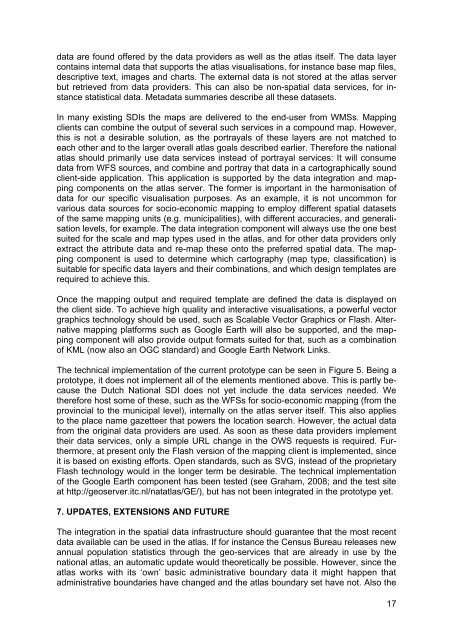SDI Convergence - Global Spatial Data Infrastructure Association
SDI Convergence - Global Spatial Data Infrastructure Association
SDI Convergence - Global Spatial Data Infrastructure Association
You also want an ePaper? Increase the reach of your titles
YUMPU automatically turns print PDFs into web optimized ePapers that Google loves.
data are found offered by the data providers as well as the atlas itself. The data layer<br />
contains internal data that supports the atlas visualisations, for instance base map files,<br />
descriptive text, images and charts. The external data is not stored at the atlas server<br />
but retrieved from data providers. This can also be non-spatial data services, for instance<br />
statistical data. Metadata summaries describe all these datasets.<br />
In many existing <strong>SDI</strong>s the maps are delivered to the end-user from WMSs. Mapping<br />
clients can combine the output of several such services in a compound map. However,<br />
this is not a desirable solution, as the portrayals of these layers are not matched to<br />
each other and to the larger overall atlas goals described earlier. Therefore the national<br />
atlas should primarily use data services instead of portrayal services: It will consume<br />
data from WFS sources, and combine and portray that data in a cartographically sound<br />
client-side application. This application is supported by the data integration and mapping<br />
components on the atlas server. The former is important in the harmonisation of<br />
data for our specific visualisation purposes. As an example, it is not uncommon for<br />
various data sources for socio-economic mapping to employ different spatial datasets<br />
of the same mapping units (e.g. municipalities), with different accuracies, and generalisation<br />
levels, for example. The data integration component will always use the one best<br />
suited for the scale and map types used in the atlas, and for other data providers only<br />
extract the attribute data and re-map these onto the preferred spatial data. The mapping<br />
component is used to determine which cartography (map type, classification) is<br />
suitable for specific data layers and their combinations, and which design templates are<br />
required to achieve this.<br />
Once the mapping output and required template are defined the data is displayed on<br />
the client side. To achieve high quality and interactive visualisations, a powerful vector<br />
graphics technology should be used, such as Scalable Vector Graphics or Flash. Alternative<br />
mapping platforms such as Google Earth will also be supported, and the mapping<br />
component will also provide output formats suited for that, such as a combination<br />
of KML (now also an OGC standard) and Google Earth Network Links.<br />
The technical implementation of the current prototype can be seen in Figure 5. Being a<br />
prototype, it does not implement all of the elements mentioned above. This is partly because<br />
the Dutch National <strong>SDI</strong> does not yet include the data services needed. We<br />
therefore host some of these, such as the WFSs for socio-economic mapping (from the<br />
provincial to the municipal level), internally on the atlas server itself. This also applies<br />
to the place name gazetteer that powers the location search. However, the actual data<br />
from the original data providers are used. As soon as these data providers implement<br />
their data services, only a simple URL change in the OWS requests is required. Furthermore,<br />
at present only the Flash version of the mapping client is implemented, since<br />
it is based on existing efforts. Open standards, such as SVG, instead of the proprietary<br />
Flash technology would in the longer term be desirable. The technical implementation<br />
of the Google Earth component has been tested (see Graham, 2008; and the test site<br />
at http://geoserver.itc.nl/natatlas/GE/), but has not been integrated in the prototype yet.<br />
7. UPDATES, EXTENSIONS AND FUTURE<br />
The integration in the spatial data infrastructure should guarantee that the most recent<br />
data available can be used in the atlas. If for instance the Census Bureau releases new<br />
annual population statistics through the geo-services that are already in use by the<br />
national atlas, an automatic update would theoretically be possible. However, since the<br />
atlas works with its ‘own’ basic administrative boundary data it might happen that<br />
administrative boundaries have changed and the atlas boundary set have not. Also the<br />
17

















